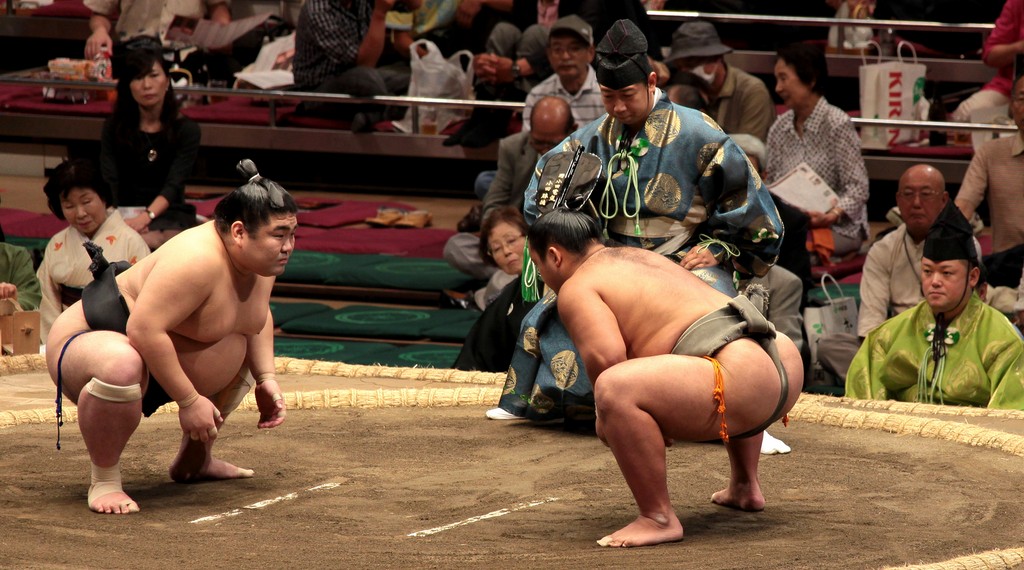PREPARATION COMBAT DE SUMO
Le tachi-ai
La plupart des combats sont gagnés dès le départ, au moment du tachi-ai. Le tachi-ai est le moment où les deux lutteurs se fixent droit dans les yeux en se concentrant pour l’assaut, s’élancent l’un contre l’autre après avoir posé ensemble les deux poings sur les shikiri sen.
La plupart des combats sont gagnés dès le départ, au moment du tachi-ai. Le tachi-ai est le moment où les deux lutteurs se fixent droit dans les yeux en se concentrant pour l’assaut, s’élancent l’un contre l’autre après avoir posé ensemble les deux poings sur les shikiri sen.
Le combat peut débuter lorsque le gyôji montre l’autre face de son gunbai ; c’est ce qu’on appelle "gunbai wo kaesu" (retourner le gunbai). Lorsque le temps maximum est passé, le rikishi qui descend du dohyô perd automatiquement le combat. Le commencement du combat est accepté de la part de chaque rikishi en touchant le dohyô des deux mains. Les deux lutteurs doivent toucher ensemble avant de démarrer. Un matta arrive quand un rikishi démarre avant que l’autre ait posé ses deux poings par terre. Celui qui prend un départ prématuré prend une amende de 10.000 yens pour ne pas s’être synchronisé avec l’autre (kokyuu wo awaseru).
-------------------------------------------
The tachi-ai (立合い) is the initial charge between two sumo wrestlers at the beginning of a bout.
There are several common techniques that wrestlers use at the tachi-ai, with the aim of getting a decisive advantage in the bout:
-------------------------------------------
The tachi-ai (立合い) is the initial charge between two sumo wrestlers at the beginning of a bout.
There are several common techniques that wrestlers use at the tachi-ai, with the aim of getting a decisive advantage in the bout:
- Charge head-first - Usually to attempt to use one's weight and momentum to force the opponent backwards out of the ring. Such a headlong charge in a low position can lead a more agile opponent to dodge out of the way and slap the charger on the back to push him to his knees.
- Try to raise the opponent up into a vertical position - Makes the opponent more vulnerable to being pushed backwards toward the ring edge and also to certain types of throw and pull down moves.
- Thrust the opponent's chest - Again force the opponent backwards towards the ringedge, or to unbalance him sufficiently to execute a beltless arm throw or a pull down move. Powerful thrusts can on occasion be enough to force the opponent to fall over in the ring.
- Slap the opponent's face - Shock the opponent into lowering his guard to gain an advantageous position, in certain cases the slap has been known to be enough to stun an opponent into falling to his knees. This move is forbidden in amateur sumo.
- Grab the opponent's belt - Use the belt to gain leverage to force an opponent backwards, or to execute a belt throw.
- React to the opponent's move - Includes dodging out of the way of an incautious charge as described above (known as henka), or dodging the attempted slap and using the opponent's lack of balance to gain an advantageous position.
- Jump over the opponent - Used famously by retired rikishi Hayateumi and Mainoumi, involves jumping high at the charge and hoping the opponent charges out of the ring.
- Surprise the opponent - Includes such moves as clapping one hands in front of the opponent's face and using the momentary blink to duck underneath to get a strong belt or leg grip to try to subsequently throw the opponent. See also Henka.
